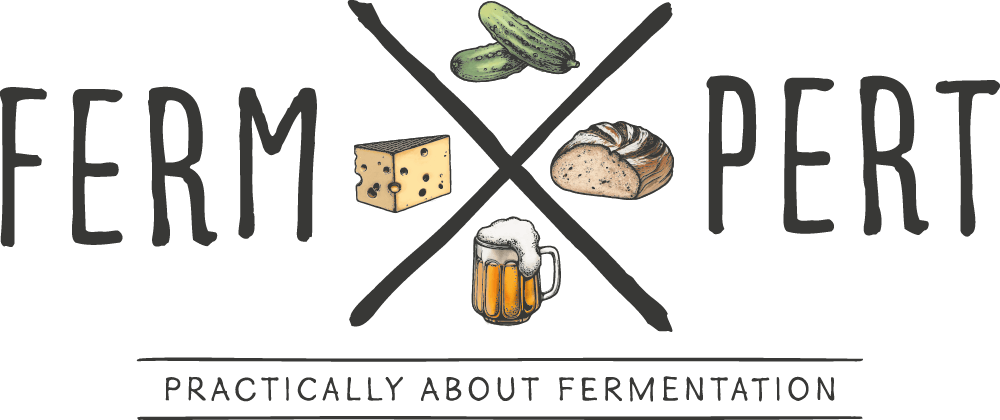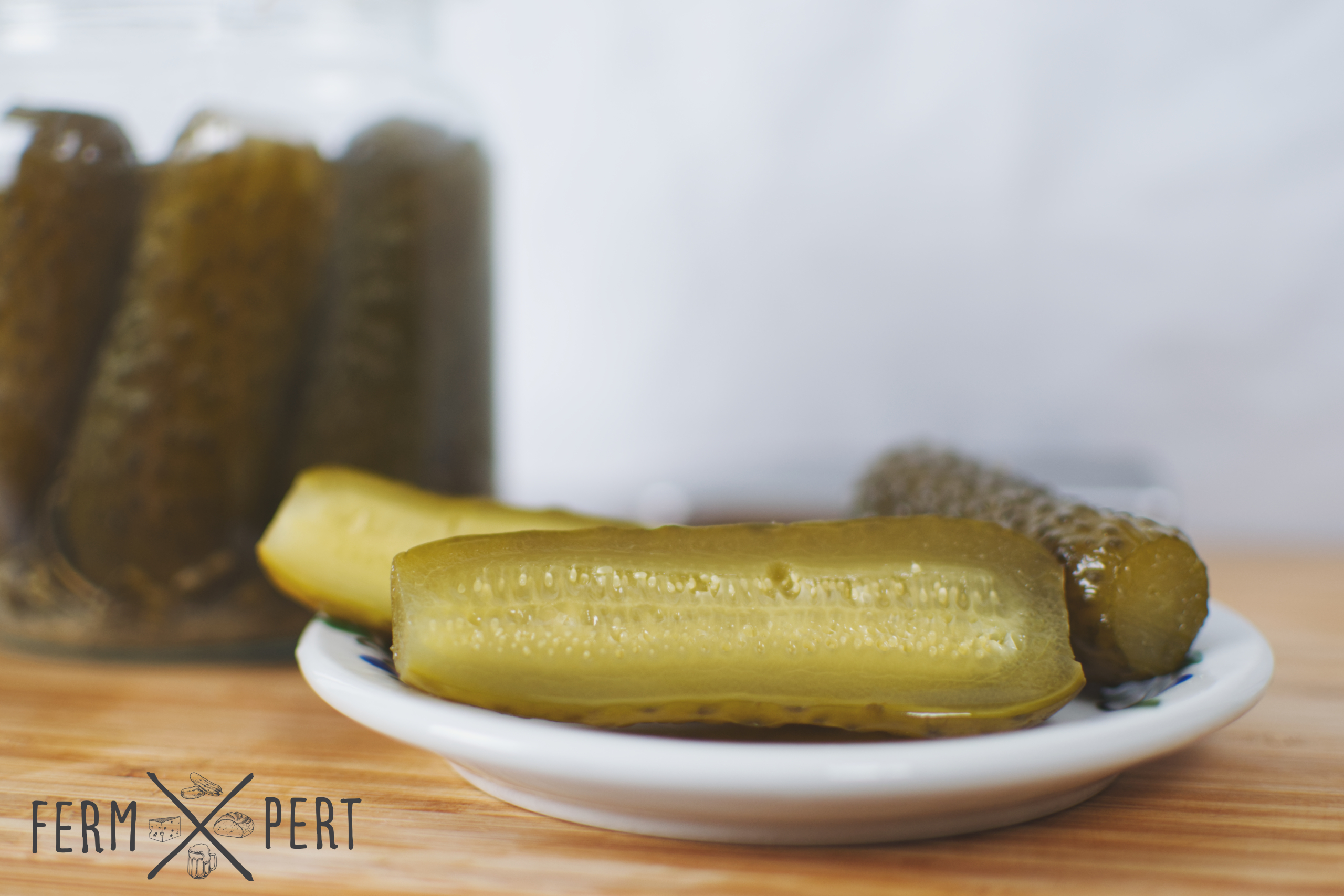In Poland, I doubt there’s anyone unfamiliar with sour gherkins, also known as dill pickles. Every grocery store sells them. However, the flavour of homemade ones is impossible to recreate commercially. Here’s my version of the recipe for this simple yet delicious food.
Recipe
- pickling cucumbers
- dill (flowers and/or leaves)
- horseradish root
- garlic
- oak leaves
- salt
- water
I intentionally skipped the ingredient amounts. They can vary according to personal preferences or the size and shape of the jar.
Wash the oak leaves (around 4 medium sized ones per kilo of cucumbers, or 2 per pound) and put them in a pot. Top with water and set it to boil. Simmer for 10-15 minutes. Set the extract aside.
Wash the cucumbers and cut off their ends.
Place 1-3 dill flowers, a small piece of horseradish root and 1-2 garlic cloves in each jar. Pack the cucumbers tightly so they don’t float.
Make a brine out of the reserved extract and salt. The concentration should be 5%. Add cold water if necessary. Pour the brine into the jars so that all ingredients are submerged. Close the lids and let the cucumbers ferment for at least 2 weeks.
Additional Information
Oak leaves can be swapped for another tannin source. However, oak gives a unique flavour. Black tea is also rich in tannins, but hardly influences the gherkin flavour.
Tannins are a pectinase inhibitor, which means that when they’re present, the gherkins remain crunchy for longer. Cutting off the cucumber ends strengthens this effect, as does a high salinity. The fourth element that reduces pectinase activity is temperature – the gherkins, after the fermentation is finished, should be stored in a cool place.
Video Transcription
Fermentation is a great way of preserving cucumbers for many months. At home, we would always prepare jars of sour gherkins in the summer in order to consume them over the rest of the year. The exact recipe can be found on the blog.
The ingredients list is short: pickling cucumbers, dill flowers, garlic, horseradish root and a source of tannins. It’s best if the cucumbers aren’t overgrown, otherwise they tend to fill with liquid.
In my case, the source of tannins are oak leaves. I like the particular flavour they impart. It’s possible to consider alternative sources or a combination thereof: vine, cherry, blackcurrant, bay or tea leaves, mustard seeds, lemon balm, peppermint and others.
It’s traditional to just place a few oak leaves in the jar along with the cucumbers, but I have a more interesting solution: I prepare an oak leaf extract.
I toss the oak leaves in a pot. Then, I pour water over them and set it to boil.
It’s complicated to tell how many leaves are needed since tannin content in oak varies across the year, plus, the actual tannin extraction is guesswork. Through trial and error I have found that four medium sized leaves per kilogram of cucumbers (that’s about two leaves per pound) works fine.
After a ten to fifteen minute boil, the extract is rosy brown in colour. I remove it from the heat and set it aside for the time being.
I move on to preparing the jars’ contents. The cucumbers have been thoroughly washed, but I still need to cut off the ends. Especially the flower end (the brighter one) needs to go since it contains the most pectinase. Pectinase is an enzyme that breaks down pectin, and pectin is what makes cucumbers crunchy. Since I’m going to store the gherkins for many months, I need to do everything in my power to weaken the pectinase effect.
Now it’s time for dill. If possible, I try to use young, green flowers. Depending on the jar size, I use one to three flowers. I place them on the bottom.
Then I add a bit of dried horseradish root.
I grab a big clove of garlic. I peel it and crush it, then toss it in the jar too.
Finally, I put cucumbers in the jar as tightly as possible. If they’re loose, they’ll float and mould will appear.
I don’t know how much brine I’m going to need, so I fill the jars with water. Then, I pour the water into a bowl and I use a kitchen scale to determine how much water there is. Additionally, if the dill sheds petals or seeds, this removes some of them. This reduces the chance of mould appearing on floating bits.
I empty the bowl and pour in the oak extract. I usually use all of my extract, but in this instance I’d prepared a bit too much, so I eyeball the required amount.
I add salt. I weigh its amount to obtain a solution with a 5% concentration. This means, for every 100 g of brine, I use 5 g of salt and 95 g of liquid. I use whatever salt I have at hand – here, it’s plain iodised table salt. The addition of potassium iodide has no noticeable effect on the end product.
I pour a little bit of hot water and stir until all the salt has dissolved. Salt dissolves faster in hot liquids. Finally, I top the brine with cold water.
I fill the jars with brine. In order to prevent cucumbers from floating, I use fermentation weights. Finally, I close the jars and that’s it. Now I wait!
The fermentation starts almost immediately. From several dozen bacterial strains, most are eliminated by the salty environment and the lack of oxygen. Lactic acid bacteria, on the other hand, are anaerobic and can survive considerable salinity. The strain that becomes dominant is Leuconostoc mesenteroides. The bacteria start to digest sugars from the cucumbers, excreting carbon dioxide and lactic acid.
After a few days, the concentration of lactic acid is too high for the Leuconostoc and another strain, more tolerant to low pH, slowly colonises the environment: Lactobacillus brevis.
The last strain to dominate the acidic environment is Lactiplantibacillus plantarum. These bacteria produce so much lactic acid that they effectively end up killing all microbes in the jar.
The fermentation signs are visible as early as on day two. The brine surface starts to foam up and the brine itself starts to become cloudy – a telltale sign of bacteria multiplying. The acidity is still low, so the cucumbers are vividly green at this stage.
A few days later, there’s a lot of foam, the brine is cloudy and a white sediment starts to appear on the bottom of the jar and on the cucumbers. The acidity is high enough to convert chlorophyll into phaeophytin, which makes the cucumbers become olive green.
After around two weeks, the fermentation is finished. The brine is clear again and there’s a lot of white sediment. It’s the dead bacteria that have precipitated out of the liquid.
Conveniently, I still have a jar of one year old sour gherkins.
The gherkins look beautiful, the smell is also perfect.
The taste is absolutely amazing. The saltiness isn’t really perceivable due to a strong lactic tang, and there’s a mild oaky background, enough to be recognisable, but without causing astringency. And they’re still crunchy!

